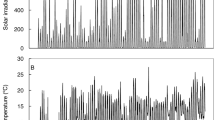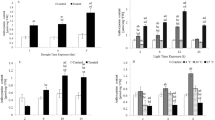Abstract
The steady-state of reactive oxygen species (ROS) in plant cells is controlled by ROS-producing and scavenging agents. A large cellular pool of antioxidant metabolites is involved in their control. Variations in this antioxidant pool may be monitored by measuring changes in hydrophilic antioxidant activity (free radical-quenching activity of water-soluble components) and ascorbic acid levels. The de-etiolation process and induction of light stress in Avena sativa and Triticum aestivum leaves were used as physiological models to study the antioxidant status at different ages. The data showed that five-day-old green plants and de-etiolated plants of the same age have similar hydrophilic antioxidant activity (∼8 μmol ASC equivalents g FW−1), which increases during the de-etiolation process. In oat and wheat, young leaves (five days old) had higher antioxidant status (hydrophilic antioxidant activity and ascorbic acid level) than old leaves (10 and 20 days old). High-light treatment caused a decrease in antioxidant status, especially in young leaves. Hydrophilic antioxidant activity and ascorbic acid levels recovered totally or partially after 30 or 60 min in the dark. This capacity also depends on age and species. The ascorbic acid/hydrophilic antioxidant activity ratio is presented as an indicator of antioxidant variations in response to stress, but taking into account the absolute levels of antioxidants.




Similar content being viewed by others
References
Alcolea JF, Cano A, Acosta M, Arnao MB (2002) Hydrophilic and lipophilic antioxidant activities of grapes. Nahrüng 46:353–356
Alcolea JF, Cano A, Acosta M, Arnao MB (2003) Determination of the hydrophilic and lipophilic antioxidant activity of white- and red wines during the wine-making process. Ital J Food Sci 2:207–214
Apel K, Hirt H (2004) Reactive oxygen species: metabolism, oxidative stress, and signal transduction. Annu Rev Plant Physiol Plant Mol Biol 55:373–399
Arnao MB (2000) Some methodological problems in the determination of antioxidant activity using chromogen radicals: a practical case. Trends Food Sci Tech 11:419–421
Arnao MB, Cano A, Acosta M (1999) Methods to measure the antioxidant activity in plant material. A comparative discussion. Free Radic Res 31:89–96
Arnao MB, Alcolea JF, Cano A, Acosta M (2001) Estimation of the free radical-quenching activity of leaf-pigment extracts. Phytochem Anal 12:138–143
Asada K (1999) The water-water cycle in chloroplasts: scavenging of active oxygens and dissipation of excess photons. Annu Rev Plant Physiol Plant Mol Biol 50:601–639
Briggs WR, Olney MA (2001) Photoreceptors in plant photomorphogenesis to date. Five phytochromes, two cryptochromes, one phototropin, and one superchrome. Plant Physiol 125:85–88
Cano A, Arnao MB (2005) Hydrophilic and lipophilic antioxidant activity in different leaves of three lettuce varieties. Int J Food Prop 8:521–528
Cano A, Hernández-Ruiz J, García-Cánovas F, Acosta M, Arnao MB (1998) An end-point method for estimation of the total antioxidant activity in plant material. Phytochem Anal 9:196–202
Cano A, Acosta M, Arnao MB (2002) Antioxidant activity: an adaptation for measurement by HPLC. In: Cazes C (ed) Encyclopedia of chromatography. Marcel Dekker Press, New York, pp 1–6
Cano A, Acosta M, Arnao MB (2003) Hydrophilic and lipophilic antioxidant activity changes during on-vine ripening of tomatoes (Lycopersicon esculentum Mill.). Postharvest Biol Technol 28:59–65
Cleland RE, Melis A, Neale PJ (1986) Mechanism of photoinhibition: photochemical reaction center inactivation in system II of chloroplasts. Photosynth Res 9:79–88
Conklin PL, Barth C (2004) Ascorbic acid, a familiar small molecule intertwined in the response of plants to ozone, pathogens, and the onset of senescence. Plant Cell Environ 27:959–970
Demming-Adams B, Adams WW, Logan BA, Verhoeven AS (1995) Xantophyll cycle-dependent energy dissipation and flexible PSII efficiency in plants acclimated to light stress. Aust J Plant Physiol 22:249–261
Dietz KJ (2003) Plant peroxiredoxins. Annu Rev Plant Biol 54:93–107
El Omari B, Fleck I, Aranda X, Abadia A, Cano A, Arnao MB (2003) Total antioxidant activity in Quercus ilex resprouts after fire. Plant Physiol Biochem 41:41–47
Eskling M, Arvidsson PO, Akerlund HE (1997) The xanthophyll cycle, its regulation and components. Plant Physiol 100:806–816
Kendrick RE, Kronenberg GHM (1994) Photomorphogenesis in plants. Kluwer, Dordrecht
McNellis TW, Deng XW (1995) Light control of seedling morphogenetic pattern. Plant Cell 7:1749–1761
Mittler R, Vanderauwera S, Gollery M, Van Breusegem F (2004) Reactive oxygen gene network of plants. Trends Plant Sci 9:490–498
Moller IM (2001) Plant mitochondria and oxidative stress: electron transport, NADPH turnover, and metabolism of reactive oxygen species. Annu Rev Plant Physiol Plant Mol Biol 52:561–591
Noctor G, Foyer CH (1998) Ascorbate and glutathione: keeping active oxygen under control. Annu Rev Plant Physiol Plant Mol Biol 49:249–279
Prasil O, Adir N, Ohad I (1992) Dynamics of photosystem II: mechanism of photoinhibition and recovery process. In: Barber J (ed) The Photosystems, topics in photosynthesis. Elsevier, Amsterdam, pp 250–348
Quail PH (2002) Phytochrome photosensory signalling networks. Nat Rev Mol Cell Biol 3:85–93
Smirnoff N, Conklin PL, Loewus FA (2001) Biosynthesis of ascorbic acid in plants: a renaissance. Annu Rev Plant Physiol Plant Mol Biol 52:437–467
Valpuesta V, Botella MA (2004) Biosynthesis of L-ascorbic acid in plants: new pathways for an old antioxidant. Trends Plant Sci 9:573–577
Acknowledgements
This work was supported by project MCyT-AGL2003-00638 (co-financed by FEDER) and by project F. SENECA 502/PI/04. J.H.R. has a contract with the University of Murcia.
Author information
Authors and Affiliations
Corresponding author
Rights and permissions
About this article
Cite this article
Cano, A., Hernández-Ruiz, J. & Arnao, M.B. Changes in hydrophilic antioxidant activity in Avena sativa and Triticum aestivum leaves of different age during de-etiolation and high-light treatment. J Plant Res 119, 321–327 (2006). https://doi.org/10.1007/s10265-006-0275-1
Received:
Accepted:
Published:
Issue Date:
DOI: https://doi.org/10.1007/s10265-006-0275-1




